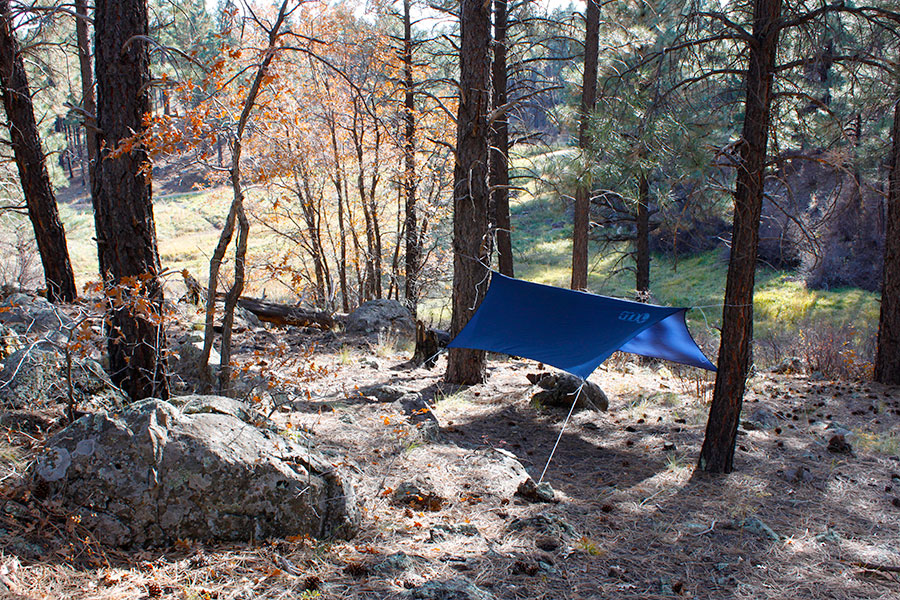Overview
The Eagles Nest Outfitters (ENO) ProFly is a rectangular tarp designed for hammocks, but can be used as a shelter or sun shade for multiple uses. There is a slight catenary cut to each edge that keeps the edges taut when pitched. The tarp is reinforced on the edges with grosgrain and on each corner a plastic LineLoc hardware device has been attached. The LineLoc accepts a small diameter line for quick guy line adjustment.
The ProFly is made from a PU-coated ripstop nylon and features a sewn and taped ridge line. The ENO logo is printed on the top right corner of each side of the tarp. Stiff line is used for all the corner and ridge line guy lines for a total of six guy points.
The stuff sack features a carry handle that also aids in pulling the sack away from the tarp when unpacking. The ProFly packs down to the size of a 1L Nalgene bottle. Stakes are sold separately.
ENO also offers the ProFly in a silnylon material that is a little more expensive but is lighter and packs down smaller.
Product Information
| MANUFACTURER | Eagles Nest Outfitters Inc | |||||||||
| YEAR OF MANUFACTURE | 2013, made in China | |||||||||
| MANUFACTURER’S WEBSITE | http://www.eaglesnestoutfittersinc.com/product/PROFLY.html | |||||||||
| MSRP |
|
|||||||||
| LISTED FEATURES |
|
|||||||||
| MANUFACTURER RECOMMENDATIONS | None listed. | |||||||||
| MEASUREMENTS |
|
|||||||||
| MATERIAL |
|

Field Experience
I have enjoyed using the ProFly for the past few months and had the fortune of experience an early August storm that included rain, sleet, and hail. As expected, the tarp performed flawlessly and kept my gear dry and protected. I’m very pleased with how small the tarp packs up, leaving more room in my pack. I tend to fold and roll this type of material as it packs down the best. Stuffing creates a slightly bulkier package that is harder to fit in the stuff sack.
Setting Up
The tarp is fairly easy to set up thanks to the included guy line. There are no stakes included in the package, so you’ll need to pick up some before you head out. In my neck of the woods I’m often surrounded by rocks that make great “stakes” so I often make use of them instead of carrying anything extra.
The guy line is very stiff. In fact, if there is one negative I have about the tarp it would be that the guy line is difficult to work with. The LineLocs are a great addition and make adjusting and tensioning very easy, except that the line is a little tough to run through it. Softer line glides through the LineLocs with ease.
To use the LineLocs with stakes, the only one-time prep work needed on the line is to tie a loop on the end of each line (a bowline or figure-8 on a bight). Once that eye loop is done, you can slip the eye over a stake and then do the tensioning/adjusting on the LineLoc.
The ProFly also uses LineLocs on the ridge line, which is an interesting choice in my opinion. The ridge line functions like the side guy lines, the only difference being that you tie off the line to the tree before adjusting.
It is possible to use aftermarket guy line and ridge lines if you want to upgrade or exchange for something you prefer better. For me, this means using lighter line that is more flexible.
Summary
For a no-nonsense, basic hammock tarp, the ProFly works great. The build and material is solid and the price point, weight, and pack size are great for the beginner hanger. The ridgeline length of 124 in (315 cm) is cutting it close for a full coverage tarp for a lot of hammocks. Admittedly, the ProFly is designed to fit the ENO line of hammocks, which are some of the shortest on the market at only 101 in (256.5 cm).
More advanced hangers who are looking to shave off additional ounces from their kit might consider the silnylon version of the ProFly. However, if you have a longer hammock (non-ENO brand), make sure to check your hammock size to ensure the best fit.
Disclosure of material connection: The author (Derek Hansen) was provided with a free sample from the manufacturer for testing and evaluation purposes. The comments in this post (written & spoken) are of my own opinion, which I formed after personally handling the gear.














Leave a Reply